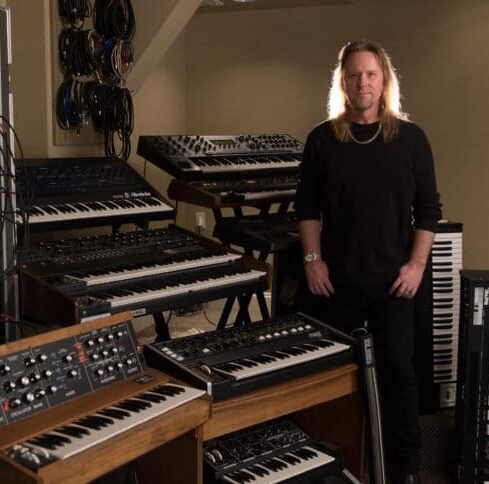
In an increasingly digital age of music creation and production, there are questions when it comes to music equipment. What is the best synthesizer to use? What even are synthesizers? What kind of synthesizer is easier for beginners? How does one choose between analog and digital synthesizers? Analog vs. digital synth is a widespread debate due to many distinctive features, including sound design and interface.
Finding the best synthesizer is a subjective choice, and it all depends on the experience one wants as a musician and what one intends to create with the synth. There are many aspects to consider, such as price, value, sound, process, rate of depreciation, ease of use, and the band’s style, to name a few.
Being a musician is more about the creation of music than the equipment used. That being said, amazing equipment heightens the natural talent of the musician. Finding the right equipment is vital. But which is better, analog vs. digital poly synth?
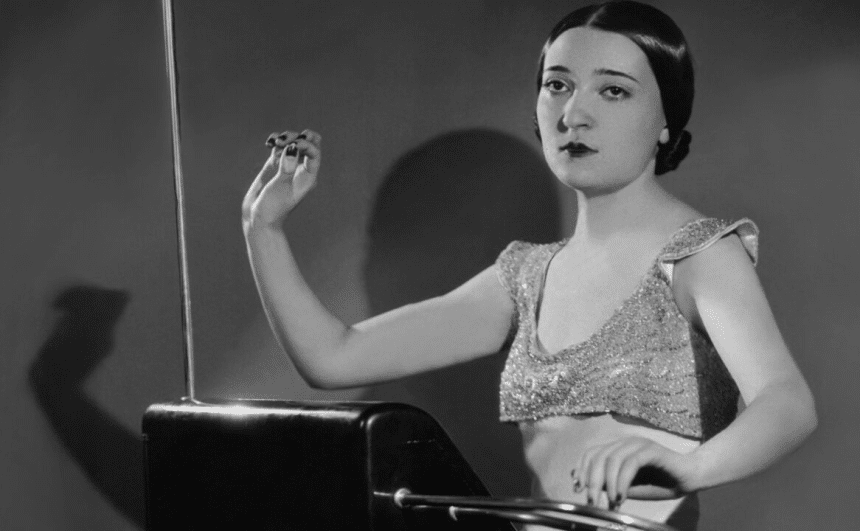
Music industry history is long and rich, with several surprising twists. This sentiment is the same for the history of synthesizers. It’s a common misconception that they began in the mid-1900s, but that’s not the case. However, its origin can be traced back to earlier than the 20th century.
It all began with an electrical engineer by the name of Elisha gray. He found that an oscillation within an electronic circuit would produce a soundwave audible to the human ear. The more he worked with it, the more he noticed that the audio could be altered to create different sounds. Thus, it can make music. This was just a single-note oscillator, but it marked the start of synthesizers.
Simply put, synthesizers or synths, are an electronic musical instrument that produces audible sounds. They consist of an oscillator, filter, amplifier, volume envelope, filter envelope, and another low-frequency oscillator that fits together to form an electronic circuit. This circuit board generates and then modifies the sound to the user’s preference. This particular design didn’t’ become the synthesizers that are used today until much later on.
The first and original version of the synth is known as the theremin. This musical instrument was originally created by a Russian inventor named Leon Theremin Trusted Source Classification | Polish folk musical instruments The MIMO (Musical Instrument Museums Online) project has created a single access point to digital content and information on the collections of musical instruments held in a consortium of European museums. folk.instruments.edu.pl for the soviet government during the Russian civil war in 1928. This Theremin works by putting frequency through the antenna, which can be altered by one’s hand towards or away from the antenna to produce differing audio. It is controlled without any direct contact from the performer or thereminist. This is an early attempt to complement a musician and their sound. Used mainly in spooky situations and scenes, this instrument is familiar to horror movie fans.
From this point on, there were more and more advancements. In the 1930s, the first polyphonic synths were being produced in both Germany and the United States of America. As they gained popularity, they began to appear in increasingly musical creations and compositions.
The rise of analog synths brought the synthesizer into the public eye. Using synths became more popular in mainstream music. Pioneers of the analog synth include names such as Harald Bode and Robert Moog Trusted Source Robert Moog | Wikipedia Robert Arthur Moog (/moʊɡ/ MOHG; May 23, 1934 – August 21, 2005) was an American engineering physicist and pioneer of electronic music. en.wikipedia.org and companies like Yamaha and Roland.
Analog synthesizers are more similar to the original instruments providing a clearer and genuine sound. Analog synthesizers such as the highly reviewed Korg MS20 Mini Semi-Modular Analog Synthesizer provide a beautiful sound. This is especially beautiful in this case with the product’s self-oscillating high-pass/low-pass filters with distinctive distortion.
Many musical bands throughout the industry have continuously used specifically analog synthesizers in their music and performances. These bands specialize in using analog synthesizers, including Laurie Spiegel, Charanjit Singh, Doris Norton, and Vangelis, to list a few examples.
Vangelis specifically utilizes the Yamaha CS80 to bring his music to life. The Greek composer Vangelis is known around the world for his work on chariots of fire (1981) and blade runner (1982).
Doris Norton also shared Vangelis’ love for the synthesizer using both the system 700 and system 100 m by Roland. Using these synths, she’s created the singles Under Ground (1980), and Personal Computer (1984) was among the first music sponsorships for apple.
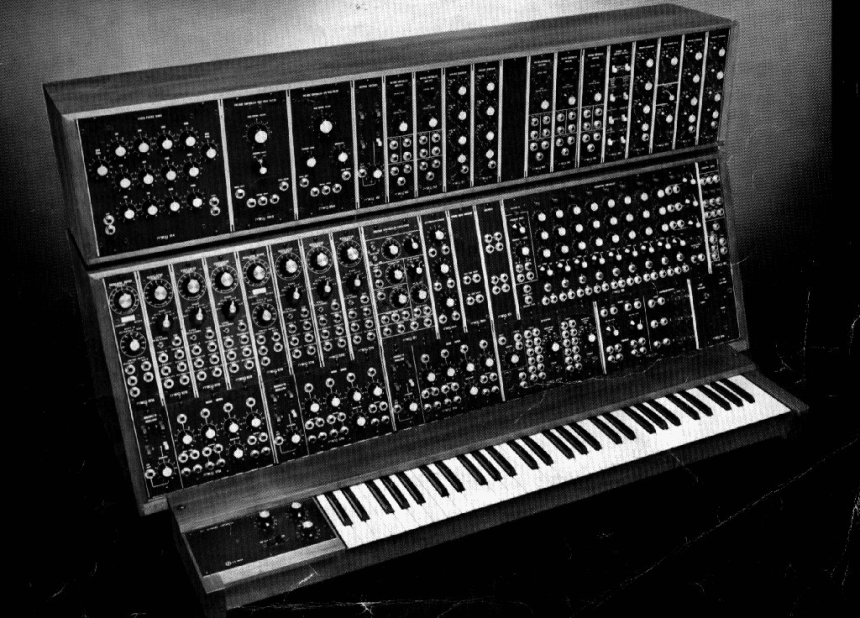 Rise of Digital Synths
Rise of Digital SynthsThe rise of digital synths was a natural progression from the digital age. This age is known for creating increasingly innovative inventions.
However, the synth boom didn’t happen until the eighties. This is due to the invention of the midi, also known as a musical instrument digital interface. It wasn’t until a decade later that virtual software instruments were created by Steinberg Trusted Source Creativity First | Steinberg With millions of users worldwide, Steinberg is one of the world’s largest manufacturers of audio software and hardware. www.steinberg.net to connect between a midi and a computer. This interface used a standard language protocol to allow multiple instruments to communicate and then be connected to computers.
Even in the rise of the digital age, analog synthesizers were still preferred by musicians because the sound they produced was much more authentic than their digital counterparts.
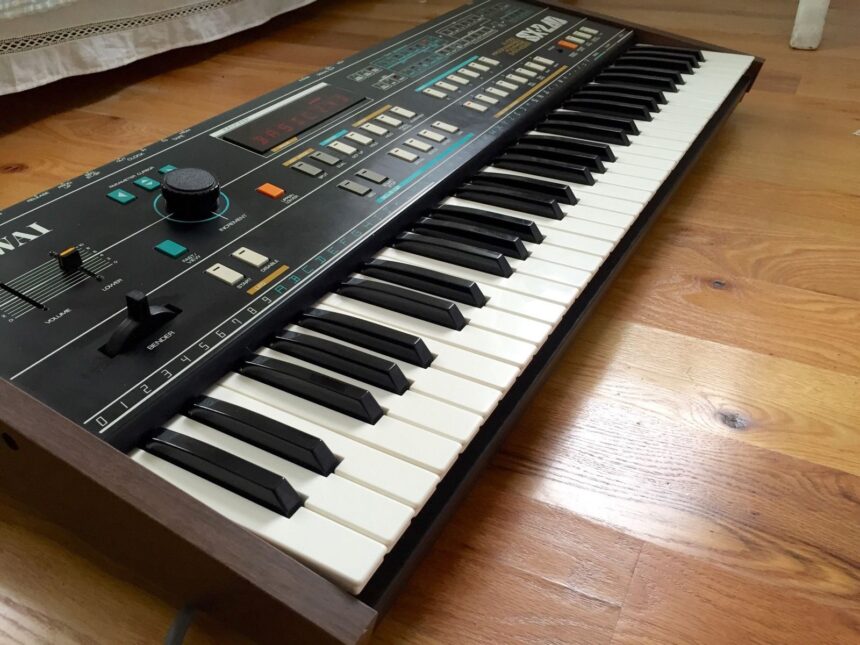
Currently, synthesizers are used throughout the music industry as a way to change the sound. With thousands of bands within a single genre, there’s a need to stand out and be proud. Synthesizers allow for that extra degree of uniqueness. There’s been a huge explosion of new synth equipment and even hybrid synths that feature the best of both analog and digital.
Synthesizers can take on several manipulation forms such as additive synthesis, subtractive synthesis, FM synthesis, phase distortion synthesis, physical modeling synthesis, and of course, sample-based synthesis. These aspects all allow a band to curate its sound.
Many famous artists have used synthesizers throughout their careers. Although Robert mood presented the Moog brand synth in 1964, it didn’t immediately grab an audience. The first one that grabbed the world’s attention was Wendy Carlos in 1968 as she performed switched-on Bach. Early artists in the sixties took to the synthesizer with albums such as The Zodiac: Cosmic Sounds by Various Artists (1967), Strange Days by The Doors (1967), Pisces, Aquarius, Capricorn & Jones Ltd. By The Monkees (1967), The Notorious Byrd Brothers by The Byrds (1968), And of course, Abby Road By The Beatles (1969).
The use of the synthesizer doesn’t stop in the ’60s, though. Artists such as Toto, Paul McCartney, Vangelis, Daft Punk, Mr. Oizo, and OMD all use synthesizers of one form or another. For example, OMD’ Bunker Soldiers’ (1980), Daft Punk ‘Da Funk’ (1995), Air ‘La Femme D’argent’ (1998), Mr. Oizo’ Flat Beat’ (1999), Felix Kubin ‘Japan’ (2003) are all created using the MS-20 monophonic synthesizer from Korg.
This instrument is utilized in modern-day recording and performances, with countless musicians utilizing synthesizers in their music.
Analog synthesizers are more closely related to traditional musical instruments such as drums, guitars among many other instruments. Playing a note with an analog synth allows the notes to be altered either harder or softer.
Many modern bands have made a name for themselves as specifically analog synthesizer bands. These are bands that specialize in using analog synthesizers not only in their music but also in their performances and music videos. Kraftwerk, John Foxx, Hot Chip, Animal Collective, and Dan Deacon are a few examples.
Compared to a digital synth, analog allows for different electronic elements to interact with each other to create unique audio depending on how the notes are played. This is hard to do with a digital synth because it’s hard to replicate those sounds accurately.
Analog synthesizers are a classic form of music creation. They have many features that make them an impressive piece of equipment.
Main features of an analog synth:
| Price | Expensive |
| Polyphony Notes | No |
| Sound Quality | Professional |
| Transportable | No |
| Modular Compatible | Sometimes |
| Hardware Compatible | Yes |
| Software Compatible | No |
| Additional Features | Vintage Process, Authentic Sound |
When it comes to choosing a synthesizer, the analog version has its benefits, but it also has drawbacks. Below is a table highlighting its pros and cons.
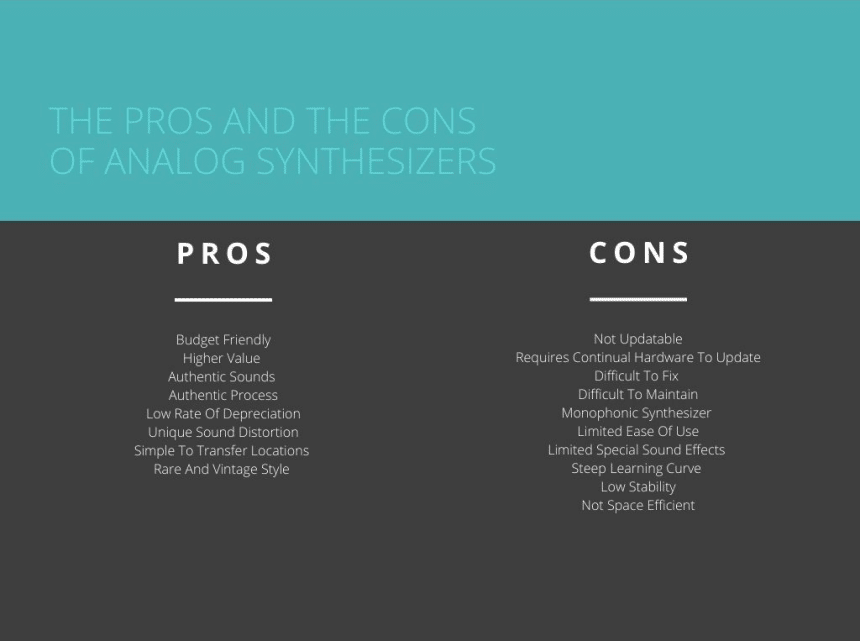 Digital Synth Overview
Digital Synth OverviewDigital synths are the popular options for many artists and musicians throughout the world.
Although they’re often considered an instrument for just EDM or techno music, that’s not the case. Digital synthesizers are an excellent addition to any band, from acoustic Irish folk music to dark opera hip hop. There’s a common misconception that synthesizers are only used in electronic music. That’s not the case at all. There are many other artists to use synthesizers in other genres. To name a few, metal musicians such as Synthesia, Dremora, Raketkanon, and Nick Gordon all utilize synthesizers. Pop artists CHVRCHES, Carly Rae Jepsen, Koto, use synths as do many hip-hop artists like Gorillaz and Casey Veggies.
Digital synthesizers are the modern form of the analogy synthesizer providing more than what the analog version could supply.
Main features of a digital synth:
| Price | Affordable |
| Polyphony Notes | Yes |
| Sound Quality | Professional |
| Transportable | Yes |
| Modular Compatible | Yes |
| Hardware Compatible | Yes |
| Software Compatible | Yes |
| Additional Features | Constant Updates, Sound Effects |
As with everything, there are both pros and cons to the equipment. Below is a table highlighting the pros and cons.
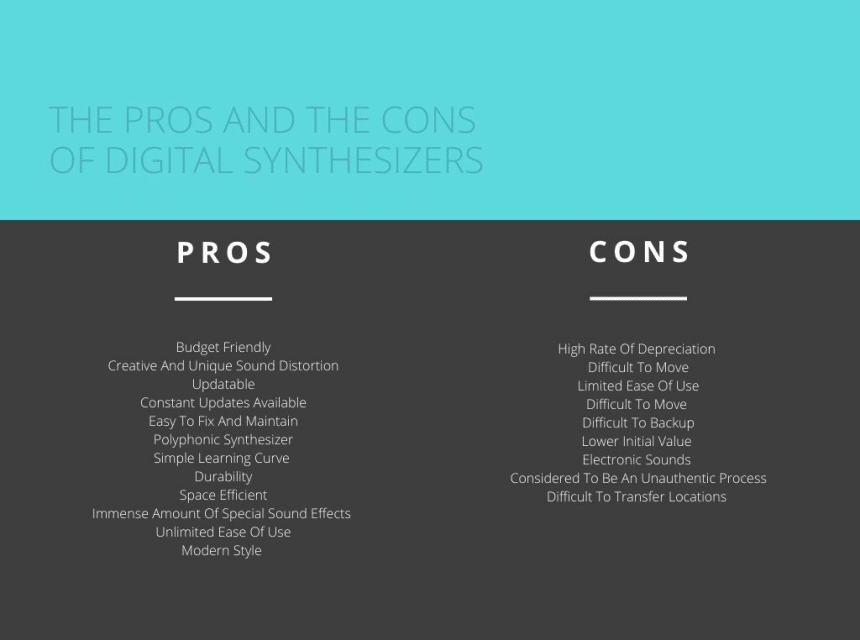 First, Hardware Synth or Software Synth?
First, Hardware Synth or Software Synth?There are two variations of synthesizers even after the separation of analog and digital synthesizers. These are hardware or software synthesizers. This makes three distinct types of synths: analog hardware synths, digital hardware synths, and digital software synths.
Hardware synths are synthesizers that are tangible and physical. One can pick this up and move it around. Software synths are only available via software on a computer, thus why there isn’t a software analog synthesizer.
On that note, a hardware synth doesn’t have to be analog, and there are digital hardware synths that bridge that middle gap.
Digital hardware synths are typically seen as instrumentals that plug into a computer. As a leading company in the synthesizer industry, Yamada has created many products for this exact purpose. Yamaha P71 88-key weighted action digital piano is just one example that provides 88 fully weighted piano-style keys, simulates the feel of an acoustic piano, and 10 different voices, including digitally sampled tones from real Yamaha acoustic grand pianos.
Choosing between these three can be difficult but considering the features makes it easy to find one for a specific sound or musical project.
Musician relies on their musical instruments to guide their creativity to create something altogether phenomenal. Choosing between an analog vs. digital synthesizer can be a big decision, but it’s possible to choose. It simply depends on how one intends to use the equipment.
There are several core differences between analog synths vs. digital synths. Each of them has its merit and uses. The main differences are outlined below. Each of them needs to be taken into consideration when choosing a new synth to add to a musicians’ process. Each of these features not only aids in determining whether an analog-digital synth is better. It also assists in determining what kind of synth overall is the best.
Some musicians swear by the authenticity of the analog synthesizer. It provides a clearer and more authentic sound. However, it’s similar to how vinyl creates a more authentic sound when CDs or speakers can create a comparable experience. This sense of holding to the classics is not only a nostalgic and charming notion, but it’s one that’s shared by a vast number of musicians.
Digital synthesizers can continuously adapt. That’s especially the case when it comes to software versions. Currently, there are software versions of many vintage synths providing a lot more options for the average musician.
An analog synthesizer provides a physical feel that even a hardware digital synthesizer can’t quite match. This is a hands-on approach to creating and distorting a sound. Vangelis explains that this style of equipment is highly valuable. He describes this as being a real tangible instrument because of its ability to be hands-on.
There is a sense of authenticity that an analog synthesizer provides when creating music. This is the reason that it’s still being used today as a prominent instrument. Its rare and vintage status makes it a unique musical instrument.
When it comes to price, it’s remarkably interesting to compare these two. It’s quite a considerable sum of money to spend without consideration. Typically, digital synthesizers will be cheaper than analog synthesizers.
As a rule of thumb, hardware is going to be more expensive than software as well as analog is going to be more expensive than digital.
Getting professional quality from sounds is not out of reach because of a low budget. It’s possible to get beautiful quality without paying excessively soaring prices. There is a middle ground with both of these synthesizers in the range of $1000. Analog synth sound vs. digital is a reasonable debate because both of these systems provide a valuable addition to a musicians’ recording studio.
When it comes to durability, both are musical equipment that is durable in the standard recording studio. That being said, if something were to happen and a synthesizer breaks, it’s easier to fix, repair, or update a digital synthesizer than an analog one.
Richard Hallum describes this exact issue in his case study from the southern institute of technology, New Zealand. His paper looks at the viability of repairing a vintage synthesizer, the Moog Polymoog keyboard. Hallum commented on the difficulty of eventually being able to repair the keyboard. Those difficulties were that the instruments were specifically made in small numbers with few in working order today.
Buying a rare vintage analog synth comes with the very real risk that it can get broken. Attempting to repair a vintage analog synth is rough because of how niche it is. Finding someone who knows how to fix it is difficult, as is finding the parts to replace it.
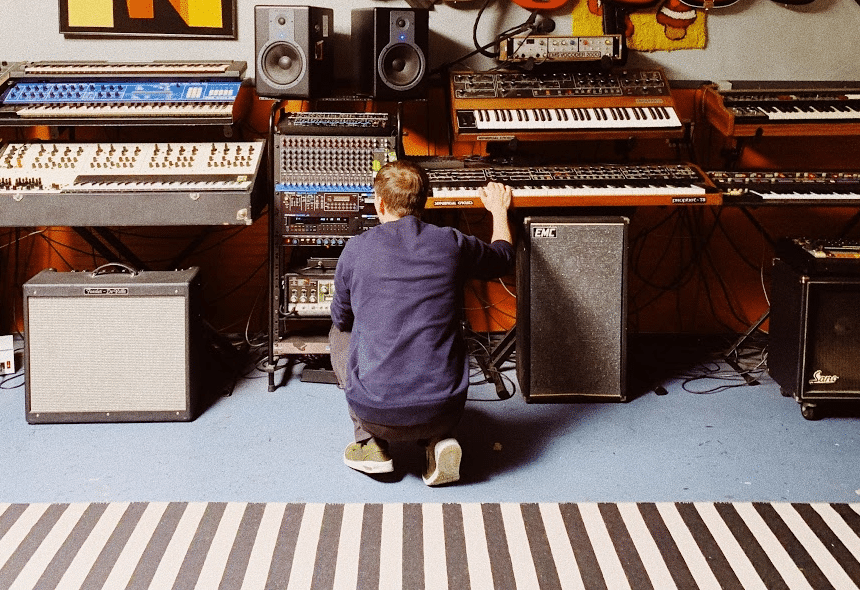
Synthesizers are a fantastic way to enhance sound. However, there is a learning curve to this as there is with everything. Producing music is made so much easier when the process is, well, simple. Digital synthesizers are simpler to learn, use, and update. This means that it’s a whole lot simpler to add unique sounds to a track using a digital synth. That being said, using them for the long term can bring up issues that make using them more difficult. Using software versus hardware means that all of that software is backed up on a computer. An analog synthesizer eliminates that issue by not need to deal with software.
That’s not to say that analog is harder to use overall. Most analog synths are harder to master for a beginner compared to digital synths. Simply put, it’s harder to do so with an analog synth. Maintaining the synth in terms of moving locations or updating the software is much simpler with an analog device. It’s as simple as plug-and-play.
That’s not the case when it comes to digital. Let’s say that there are over one thousand sounds and recordings. Technology doesn’t always age well, and it will be harder to run on a computer as it ages. Once a computer has outlived its prime, transferring, installing, or downloading all of the content again can be a pain.
Analog synthesizers have a more original sound providing a purer authentic sound. This provides a more vintage experience to music creation. But that does have its drawbacks.
When it comes to analog synths, any additions to the sounds or styles typically include the addition of hardware. Inserting a keyboard here and another one there tends to take up a lot of physical space. On top of any speakers, computers, mics, amplifiers, and other equipment needed, it’s just more space that many musicians simply don’t have. Unless the space is there for a large recording studio, having a lot of hardware synths out and ready to go is not easy at best and impossible at worst.
With digital synths, this is much less of a problem. These digital synths don’t use up a lot of physical space, but digital space on a computer’s hard drive. When these bog down your system, it’s simple enough to add additional space to a computer.
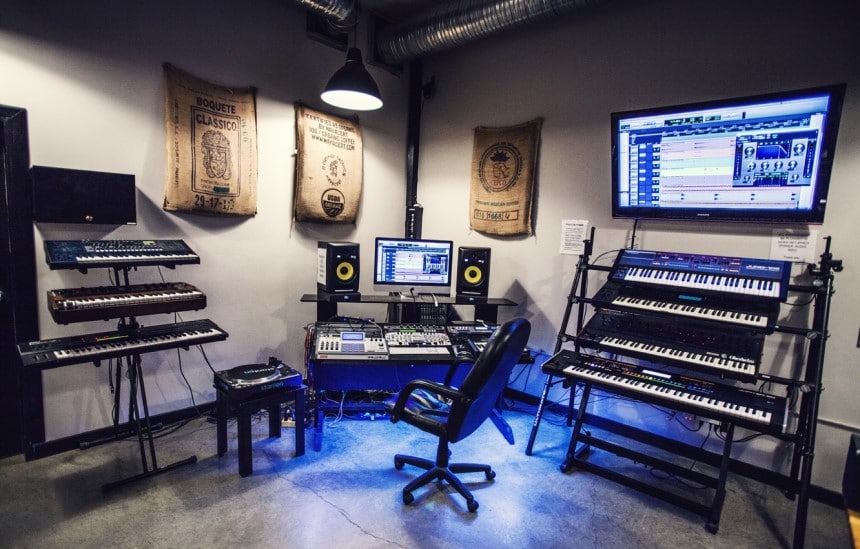
Ensuring the proper organization for the music is also vital. When it comes to notes, there are two terms to keep in mind. Polyphony is the total number of notes playing simultaneously. Multitimbrality is the total number of different presets playing at the same time. These two terms are important due to the unusual ways to use a synth to create a melody.
Which is better, analog vs. digital poly synth? When it comes to making music, layers and different notes are key. A polyphonic synthesizer can play more than two notes at the same time. This makes it simple to create diverse and creative beats. Most early synth designs were monophonic. They didn’t have the addition of multiple notes being played simultaneously. That’s not a problem if it’s the process that’s of interest. There’s something to be said for staying true to the art form. Taking the authentic sound of the analog synth makes for an authentic sound for a song. However, modern music is known for its different layers and genre mashups and shifts. Thus, using a polysynth makes it easier to create music.
Analog vs. digital synth differences are compared in the figure below to assist in the visualization and decision making. There are various features, including creative and unique sound distortion, functional price range and value, notes, learning curve, durability, and space efficiency. As discussed previously, there’s a lot of features to consider.
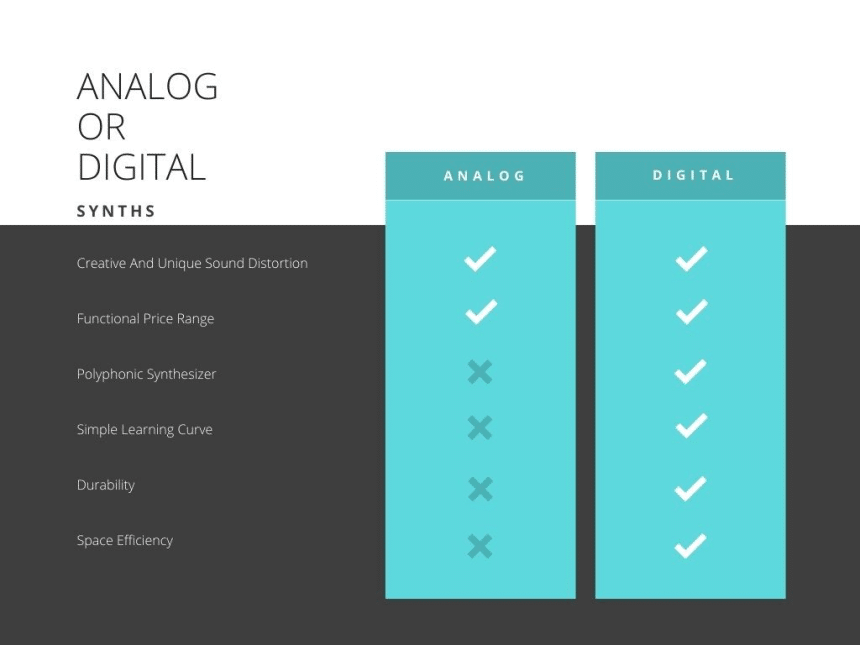 So, What’s the Best Choice for You?
So, What’s the Best Choice for You?Music is a very personal and subjective industry that relies on passion and emotion to convey throughout the song.
Analog is typically best for those that are more advanced or want that extra challenge. There’s a prestige to this, which is helpful if that’s the sound and persona needed for that band and its sound.
Digital synths are perfect for those that are new to employing synthesizers as they’re easier to use and are cheaper overall. This is a perfect option for the general musician.
Creating a meaningful song means using instruments that mean something to the musician. When it comes to creating music, it’s up to what’s right for the music maker. Deciding between an analog synthesizer or a digital one depends on what sound and process are needed for the band.
Adding a synthesizer to a home recording station or a blossoming producing office is a wonderful way to increase the uniqueness and musical creativity of a song. This is vital in today’s music industry. Current musicians need to stand out in the sea of thousands and thousands of artists in America alone. Bringing forward a whole new sound is what every artist is aiming for. A synth is just one way to do just that.
With the increasing innovation in the modern music industry, there’s no shortage of new synthesizers. Regarding the features of synthesizers, there’s a lot to consider. Analog vs digital synth provides a lot of features and elements to contemplate. When it comes down to it, it’s about individual preference and taste. Comment below to let us know what synthesizer you prefer!